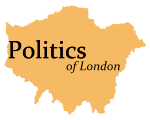
The Greater London Authority (GLA), colloquially known by the metonym City Hall, is the devolved regional governance body of Greater London, England. It consists of two political branches: an executive Mayor and the 25-member London Assembly, which serves as a means of checks and balances on the Mayor. Since May 2016, both branches have been under the control of the London Labour Party. The authority was established in 2000, following a local referendum, and derives most of its powers from the Greater London Authority Act 1999 and the Greater London Authority Act 2007.

The Greater London Council (GLC) was the top-tier local government administrative body for Greater London from 1965 to 1986. It replaced the earlier London County Council (LCC) which had covered a much smaller area. The GLC was dissolved in 1986 by the Local Government Act 1985 and its powers were devolved to the London boroughs and other entities. A new administrative body, known as the Greater London Authority (GLA), was established in 2000.

The coat of arms of the United Kingdom are the arms of dominion of the British monarch. They are both the personal arms of the monarch, currently King Charles III, and the arms of the state. In addition to the monarch, the arms are used by state institutions including the Government of the United Kingdom, the Parliament of the United Kingdom, and the British judiciary. Differenced versions of the arms are used by members of the British royal family. The monarch's official flag, the Royal Standard, is the coat of arms in flag form.

The coat of arms of England is the coat of arms historically used as arms of dominion by the monarchs of the Kingdom of England, and now used to symbolise England generally, but not officially. The arms were adopted c.1200 by the Plantagenet kings and continued to be used by successive English and British monarchs; they are currently quartered with the arms of Scotland and Ireland in the coat of arms of the United Kingdom. Historically they were also quartered with the arms of France, representing the English claim to the French throne, and Hanover.
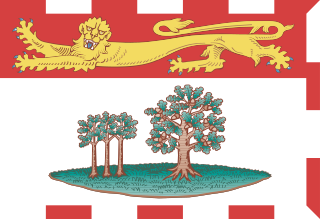
The flag of Prince Edward Island consists of a golden lion passant on a red field in the upper portion and a white field charged with three oak saplings and a large oak tree on a green island in the bottom portion. This is bordered on three edges other than the hoist by a fimbriation of alternating red and white rectangles. Adopted in 1964 in the run-up to the Canadian Centennial, it has been the flag of the province since March 24 of that year. It is a banner of arms modelled after the province's coat of arms. When flown with the flags of other Canadian provinces and the national flag, it is eighth in the order of precedence.

The coat of arms of Newfoundland and Labrador was originally granted by Garter King of Arms, during the reign of King Charles I, on 1 January 1637/8.
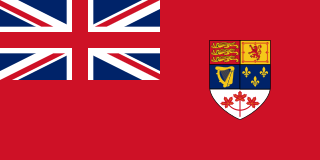
The Canadian Red Ensign served as a nautical flag and civil ensign for Canada from 1892 to 1965, and later as the de facto flag of Canada before 1965. The flag is a British Red Ensign, with the Royal Union Flag in the canton, adorned with the shield of the coat of arms of Canada.

The coat of arms of Ireland is blazoned as Azure a harp Or, stringed Argent. These arms have long been Ireland's heraldic emblem. References to them as being the arms of the king of Ireland can be found as early as the 13th century. These arms were adopted by Henry VIII of England when he ended the period of Lordship of Ireland and declared Ireland to be a kingdom again in 1541. When the crowns of England, Scotland and Ireland were united in 1603, they were integrated into the unified royal coat of arms of kingdoms of England, Scotland and Ireland. The harp was adopted as the emblem of the Irish Free State when it separated from the United Kingdom in 1922. They were registered as the arms of Ireland with the Chief Herald of Ireland on 9 November 1945.

The Bureau of Heraldry is the South African heraldic authority, established in Pretoria on 1 June 1963. It is headed by a State Herald and its functions are to register arms, badges, flags and seals, to keep a public register, to issue registration certificates and, since 1980, to advise the government on heraldic matters. Together with the Heraldry Council, it forms part of the National Archives and Records Service, which is currently under the authority of the Minister of Sports, Arts and Culture.

The first coat of arms of Montreal was designed by Jacques Viger, the first mayor of Montreal, and adopted in 1833 by the city councillors. Modifications were made some one hundred five years later and adopted on 21 March 1938, and again on 13 September 2017, resulting in the version currently in use. The coat of arms was the only city emblem representing Montreal until 1981, when a stylized logo was developed for common daily use, reserving the coat of arms for ceremonial occasions.
The Stafford knot, more commonly known as the Staffordshire knot, is a distinctive three-looped knot that is the traditional symbol of the English county of Staffordshire and of its county town, Stafford. It is a particular representation of the simple overhand knot, the most basic knot of all.

A Royal Badge for Wales was approved in May 2008. It is based on the arms borne by the thirteenth-century Welsh prince Llywelyn the Great, with the addition of St Edward's Crown atop a continuous scroll which, together with a wreath consisting of the plant emblems of the four countries of the United Kingdom, surrounds the shield. The motto which appears on the scroll, PLEIDIOL WYF I'M GWLAD, is taken from the National Anthem of Wales and is also found on the Welsh designs for £1 coins minted from 1985 until 2000. The badge formerly appeared on the covers of Assembly Measures; since the 2011 referendum, it now appears on the cover of Acts passed by the Senedd and its escutcheon, ribbon and motto are depicted on the Welsh Seal.
The history of local government in London, England, can be broken down into a number of periods.
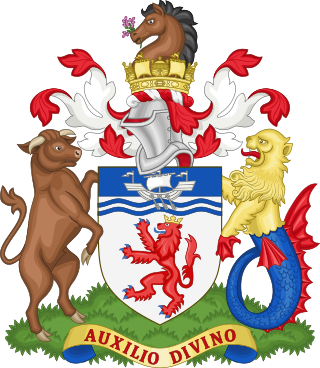
Devon County Council is the county council administering the English county of Devon. Based in the city of Exeter, the council covers the non-metropolitan county area of Devon. Members of the council (councillors) are elected every four years. Almost all councillors are members of the major national political parties.

The coat of arms of the city of Victoria was granted in 1962, and then subsequently registered with the Canadian Heraldic Authority in 2005. While the city employs a logo for common use, the arms are reserved for legal documents and for more historical or traditional purposes and events.
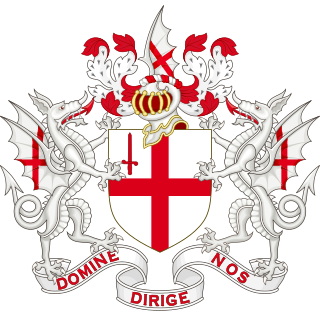
The coat of arms of the City of London Corporation is the official coat of arms granted to the City of London Corporation. The Corporation governs the City of London, one of the 33 administrative areas within Greater London, England.
Greater Manchester does not currently have an official flag. The former Greater Manchester County Council used a heraldic banner of its arms during its existence between 1974 and 1986.

The coat of arms of the London Borough of Haringey was granted on 10 May 1965, after the mergers of the former Municipal Borough of Hornsey, the Municipal Borough of Wood Green and the Municipal Borough of Tottenham. Unlike most other London boroughs, it was decided not to create arms based on the charges in the coats of arms of the former boroughs.
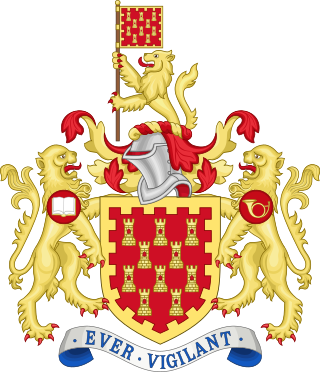
The coat of arms of Greater Manchester County Council was the coat of arms granted by the College of Arms to Greater Manchester County Council when the latter was created in 1974. The county council was the top-tier local authority for Greater Manchester between 1974 and 1986, when the council was abolished and its arms fell into disuse.

The seal of Cincinnati is the official insignia of the city of Cincinnati, Ohio, in the United States. Adopted in 1819, the seal incorporates scales, a sword, and a caduceus. The seal is featured prominently in the flag of Cincinnati and the insignia of city agencies and institutions.
